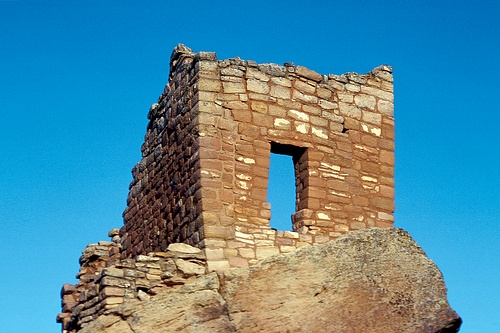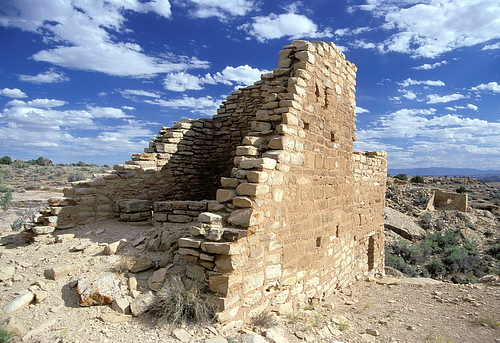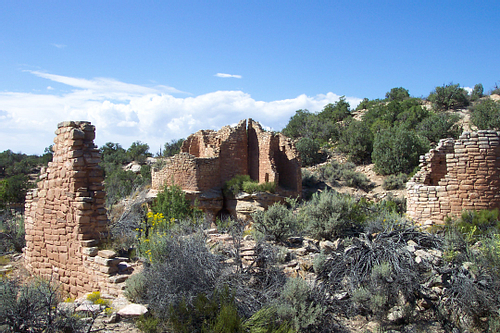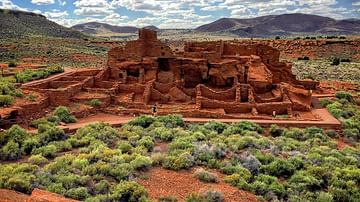
Hovenweep or Hovenweep National Monument is comprised of the ruins of six Ancestral Puebloan (or Anasazi) villages located on the border between southwestern Colorado and southeastern Utah in what is the present-day United States. The home of roughly 2500 people who built an impressive array of structures, including unusual towers in square and circular forms, D-shaped houses, and ceremonial kivas from c. 1150-1300, Hovenweep was abandoned c. 1300 under mysterious circumstances. While known by the Ute and Navajo tribes for centuries, the ruins that now comprise Hovenweep National Monument were “rediscovered” by William D. Huntington and a band of Mormon pioneers in 1854. They became a US National Monument in 1923, at the request of US President Warren G. Harding, and they are now under the administration of the US National Park Service.
Geography & Prehistory
The name "Hovenweep" is translated to "deserted valley" in the Paiute/Ute language. The six ruins that form the Hovenweep National Monument are located very close to the southern borders of US states of Colorado and Utah. The nearest towns to the ruins are that of Cortez, Colorado and Blanding, Utah, and the ruins are set upon the Cajon Mesa in the Great Sage Plain.
The six ruined villages span around an area of 32 km (20 miles), forming a group of six disconnected acres of Ancestral Puebloan ruins. Four of the sites — Holly, Horseshoe and Hackberry, Cutthroat Castle, and Goodman Point — are located in Colorado near or on Paiute/Ute lands. The other two — Square Tower and Cajon — are in Utah near Navajo lands.
Archaeology confirms that humans have inhabited the region around Hovenweep for nearly 10,000 years. There are countless Paleoindian sites between the canyons and on top of mesas in and around Hovenweep. Nomadic tribes of Native Americans frequented the Cajon Mesa to hunt wild game and gather food on a seasonal basis. Pinyon-juniper woodlands remain abundant in the vicinity of Hovenweep.
Ancestral Puebloans at Hovenweep
Sedentary farming by the ancestors of the Ancestral Puebloan culture began in the 6th century. They cultivated the land and practiced small-scale farming with terraces to catch runoff rainwater. They also built storage granaries under the rims of canyons for their crops and produce. There were and still are tributaries and streams that flow through the canyons into the San Juan River, ensuring that the land and climate around Hovenweep was hospitable to the cultivation of beans, squash, and corn in prehistoric and ancient times.
Around 900, the Ancestral Puebloan people began to farm in the environs of Hovenweep with tower-building commencing c. 1000. The Ancestral Puebloan people initially constructed simple one-story towers attached to either L-shaped or U-shaped pueblo structures, but they gradually built large complexes with kivas, arroyo dams, spring-fed gardens, and exquisitely engineered square or circular towers by c. 1160. (It should be noted, however, that the Ancestral Puebloan people built the majority of the canyonhead towers between c. 1230-1280.) Many of these towers sit atop canyon rims and are expertly but precariously balanced upon large boulders. The masonry construction of these towers is striking when one compares Hovenweep to the contemporaneously built Cliff Palace, which is located in the nearby Mesa Verde National Park, as many of the towers have remained in place for nearly 800 years.
It is entirely plausible that the Ancestral Puebloan people may have used Hovenweep's towers as astronomical observatories during the winter and summer seasons for agricultural and ceremonial purposes. However, the research of many archaeologists and scholars has revealed that the towers also contained living rooms, toolmaking and grinding quarters, and even large storage spaces. It is quite likely too that the towers' purpose, at least in part, was also for defense and signaling the presence of danger. Many scholars have additionally noted the strong correlation between the towers and kivas. The towers thus seem to have had several purposes rather than a single-function usage.
Aside from the towers and ruined villages, archaeologists have determined that the inhabitants of Hovenweep shared much in common with their neighbors at Mesa Verde, Chaco Canyon in New Mexico, and Canyon de Chelly in Arizona. Architectural and artistic similarities in design and masonry tie Hovenweep closely to the peoples who lived at Mesa Verde in particular. It is worth noting that the ruins at Hovenweep are located in close proximity to many important, contemporaneous Pre-Columbian sites in what is present-day Colorado: Escalante Pueblo and Dominguez Pueblo (fl. 900-1300) in Dolores, Colorado; Lowry Pueblo (fl. 1050-1220), Painted Hand Pueblo (fl. 1200-1300), and Sand Canyon Pueblo (fl. 1250-1290) located in Canyons of the Ancients National Monument near Pleasant View, Colorado; Albert Porter Pueblo (fl. 1000-1300), Castle Rock Pueblo (fl. 1000-1300), Shields Pueblo (fl. 1000-1300), Woods Canyon Pueblo (fl. 1000-1300), and Yellow Jacket Pueblo (fl. 1000-1300) which are located near Cortez, Colorado; and Cliff Palace (fl. 1190-1300) and its adjacent cliff dwellings in Mesa Verde National Park near Cortez, Colorado; and Yucca House (fl. 1150-1300) near Cortez, Colorado.
Mysterious Departure & 19th-century CE 'Rediscovery'
The abandonment of Hovenweep remains an enduring mystery. Over the past century, archaeologists, historians, and scientists have tried to pinpoint the root causes of the massive abandonment of settlements like Hovenweep, Canyon de Chelly, and Mesa Verde, but there is no single consensus among experts. Whether due to internecine warfare, severe drought and food shortages as a result of unfavorable climatic conditions, or the emergence of new religious and cultural centers, Hovenweep's inhabitants left the area and migrated in a southerly direction towards the Rio Grande Valley in what is present-day New Mexico and the Little Colorado River Basin in what is present-day Arizona. Their descendants —the Pueblos of New Mexico, the Zuni, and the Hopi — are the inheritors of their rich traditions in artistic and architectural production.
Following the collapse of the Ancestral Puebloan Culture, new tribes like the Navajo, Apache Utes, and Piaute entered into the region between c. 1400-1500 and encountered the ruins of Hovenweep. Although William D. Huntington and a band of Mormon pioneers stumbled upon the structures of Hovenweep in 1854, it was the US photographer William Henry Jackson who first employed the "Hovenweep" name in 1874 when he photographed the site. J. W. Fewkes of the Smithsonian Institution surveyed Hovenweep between 1917-1918, and he was the first to recommend that the structures be protected. US President Warren D. Harding placed Hovenweep under the protection of the National Park System in 1923. While there has been archaeological work undertaken at Hovenweep from the 1920s until today, Hovenweep has never been fully excavated despite its importance.









